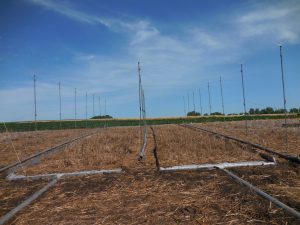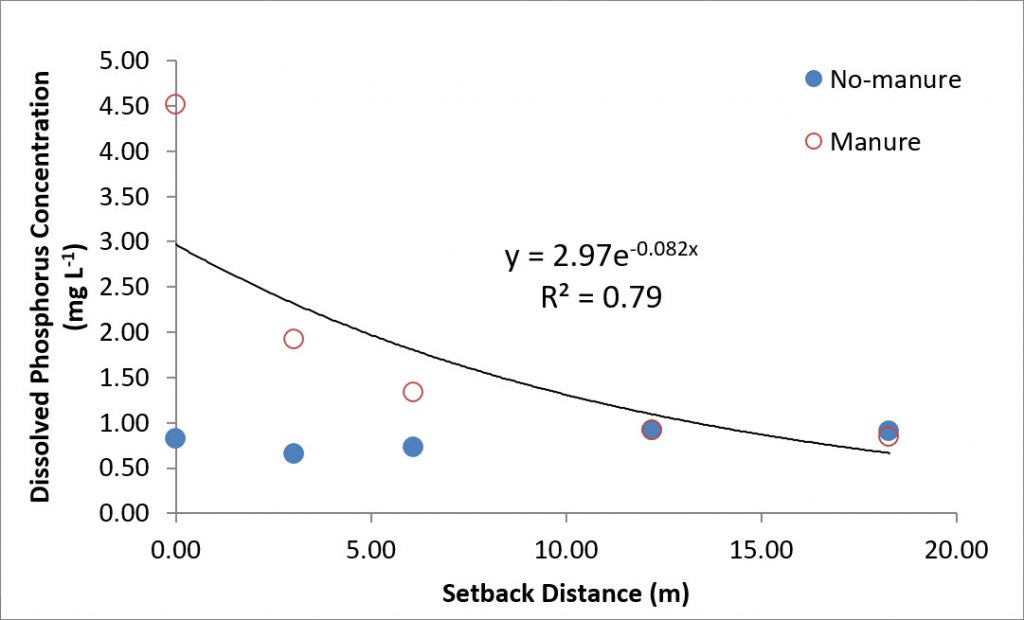Setbacks Reduce the Concentration of Manure Constituents in Runoff
What setback distance is required to reduce the concentration of manure constituents in runoff to background values? John E. Gilley, Aaron J. Sindelar, and Bryan L. Woodbury, researchers with the USDA-Agricultural Research Service, examined the effects of setback distance on concentrations of selected constituents in runoff following land application of beef cattle manure to a site in Southeast Nebraska (Figure 1).

Figure 1. A field rainfall simulation study was performed to identify the effectiveness of setbacks in reducing cattle manure constituents in runoff. The paired plots shown above containing winter wheat residue were 3.7 m (12.1 ft) wide and 23.2 m (76.1 ft) long.
This blog reviews results published in a Transactions of the ASABE article “Removal of Cattle Manure Constituents in Runoff from No-till Cropland as Affected by Setback Distance”. An article identifying “Setback Distance Requirements for Removal of Swine Slurry Constituents in Runoff” was also published recently in Transactions of the ASABE and the second publication provides similar information.
What Are Setbacks?
A cropland setback is an area where manure is not applied but crops continue to be grown. The transport of contaminants is reduced on setback areas by increasing the distance overland flow must travel to reach surface water bodies. Environmental Protection Agency requirements for a concentrated animal feeding operation dictate that manure be applied no closer than 30.5 m (100 ft) to any down-gradient surface water, open tile intake structure, sinkhole, agricultural well head, or other conduit to surface waters (EPA, 2012). Commercial fertilizer may be added and crops grown in setback areas and appropriate conservation practices should be implemented.
Field Experimental Conditions
The long-term no-till study site on which the study was preformed had a residue cover of 8.84 Mg ha-1 (7890 lb acre-1) and a slope gradient of 6.2%. The twenty plots examined during the investigation were 3.7 m (12.1 ft) across the slope by 4.9 m (16.1 ft), 7.9 m (25.9 ft), 11.0 m (36.1 ft), 17.1 m (56.1 ft) or 23.2 m (76.1 ft) long. An initial set of rainfall simulation tests were completed to determine background concentrations of selected constituents. Cattle manure was then applied to the upper 4.9 m (16.1 ft) of each plot and additional rainfall simulation tests were conducted.
Experimental Results
Lesson 1: A first-order exponential decay function can be used to quantify the effectiveness of setback distance in reducing the concentration of selected runoff constituents including dissolved phosphorus (Figure 2). Dissolved phosphorus was selected for illustration because it is an important parameter used to determine potential environmental impacts resulting from manure application. The experimental results obtained for dissolved phosphorus were also characteristic of measurements reported in this study for other water quality parameters.

Figure 2. Concentration of dissolved phosphorus in runoff as affected by setback distance for the manure and no-manure treatments. The regression equation that is shown is for the no-manure condition.
Lesson 2: A setback distance of 12.2 m (40 ft) effectively reduced the concentrations of DP to background values similar to those measured on the no-manure treatment (Figure 2). Similar results were found for NH4-N, boron, calcium, magnesium, potassium, and sulfate.
Take Home Message: For the given experimental conditions, the concentration of selected pollutants in runoff following land application of cattle manure was significantly reduced when appropriate setback distances were used.
Author: John E. Gilley, USDA-ARS, Lincoln, Nebraska
Reviewer: Rick Koelsch, University of Nebraska – Lincoln
